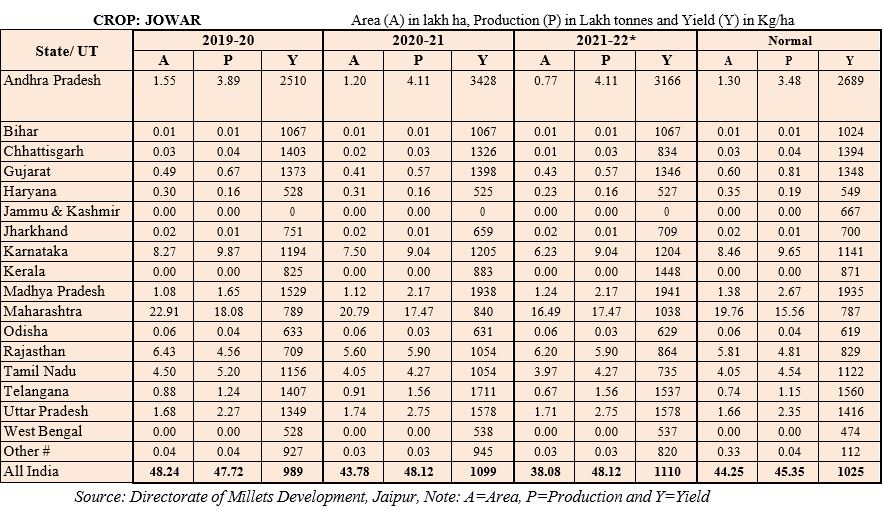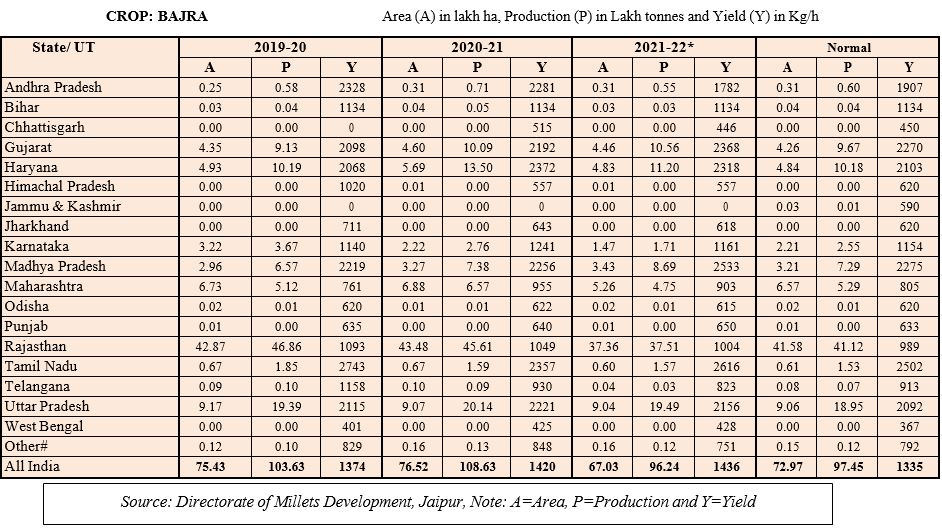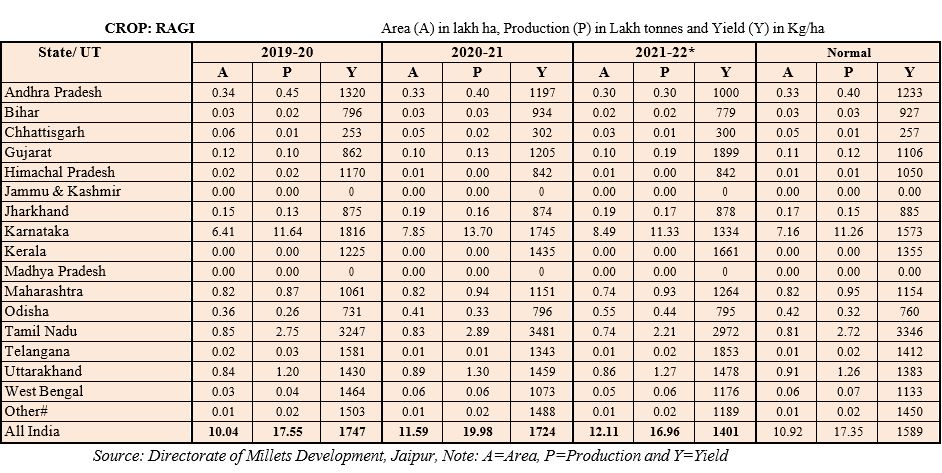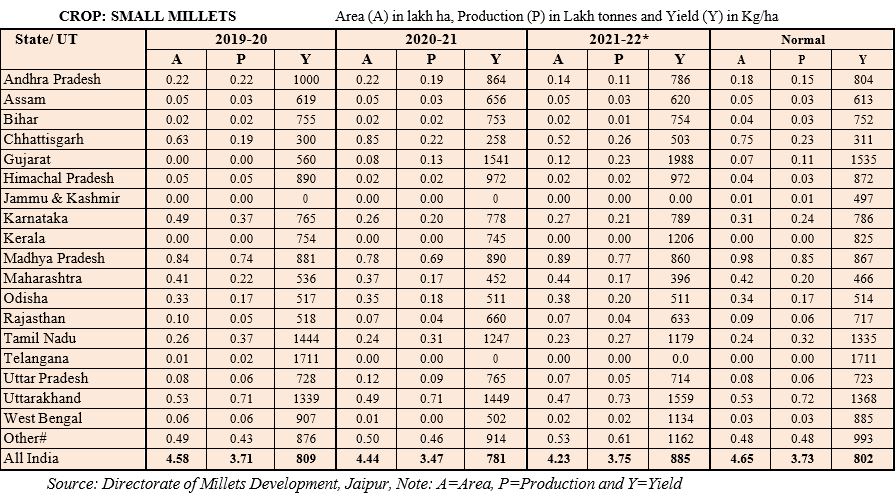Coarse Cereals : A Promising Approach to Indian Agriculture
Rambha Kumari
September 17th 2025, 9:01:17 pm | 5 min read

1. INTRODUCTION
In our country, coarse cereals are mainly grown in poor agroclimatic regions, particularly rainfed areas of the country. These crops are grown in areas with high temperatures and are called dryland crops because can be grown in areas with 50-100 cm rainfall. These crops are less sensitive to soil deficiencies and can be grown in an inferior alluvial or loamy soil. Currently, India holds the 4th position in the world in coarse cereal production after USA, China & Brazil but the amount produced is only 3.6% of the global coarse cereal production. As per 2016 figures, Rajasthan, Karnataka and Madhya Pradesh are the top coarse cereal producer states of India. Coarse cereals like sorghum (Jowar), pearl millet (bajra), finger millet (ragi) and other coarse staples like maize, barley, and oats had been traditionally an important component of the Indian food basket. These cereals are given by our ancestors because in past times our forefathers cultivate such type of crop. However, after the green revolution, the crop cycle primarily moved to wheat and rice. Even the areas in the northwestern part of the country, where the rainfall and water level are low, started growing rice because it was being purchased by the government on minimum support price (MSP).
1.1 A VISION OF COARSE CEREALS IN INDIA
For centuries, India used to consume primarily coarse grains like jowar (sorghum), bajra (pearl millet), and ragi (finger millet). However, countries around the world are moving from wheat and rice to coarse grains giving the health benefits. Given the rising global demand for coarse grains, India can become a major exporter of these grains and earn billions of dollars in foreign exchange. So, the government is incentivizing farmers to grow coarse grains through farmer-produce organizations (FPOs). In the last few years, Prime Minister Modi has laid a lot of emphasis on coarse grains. The Prime Minister touched upon the UN recognition of the year 2023 as the International Year of Millets and stressed the need to promote coarse grain as it will not only provide nutritious food grain but will also add to the income of the farmers. Last year in June, Food and Public Distribution Minister, Piyush Goyal also emphasized the need to increase the production and procurement of coarse grains. “Time has come to revise norms to incentivise the farming and distribution of coarse grains in India,” said the minister.
As per a report by The Indian Express, “intending to match the cultivation of nutri-cereals with local topography and natural resources, the government is encouraging farmers to align their local cropping patterns to India’s diverse 127 agro-climatic zones. Provision of seed kits and inputs to farmers, building value chains through Farmer Producer Organisations and supporting the marketability of nutri-cereals are some of the key interventions that have been put in place. The government has renamed jowar, bajra, ragi and other millets as “Nutri Cereals” to emphasize their nutritional value.” Now under this Abhiyan, the grains that are being distributed under various schemes such as food guarantees and mid-day meals will be bio-fortified to increase their nutritional value.
1.2 IMPORTANT FACTORS FOR THE PROMOTION OF COARSE CEREAL
- The coarse cereals require much less water to grow than rice and wheat
- They can be successfully cultivated in semi-arid tropics and poor soils
- They are more efficient converters of energy and plant nutrients into biomass.
- Some of them are capable to deliver a higher yield per hectare in comparison to wheat and rice if there is a proper use of modern farm technology and hybrid seeds

Source: Google Image
1.3 NUTRITIVE VALUE OF MILLETS (100GM/SERVING)
| Calorie | 378 |
| fat | 4.22g |
| Dietary fiber | 8.5g |
| calcium | 8 mg |
| Potassium | 195 mg |
Source: Monsoon harvest team 2022
Per 100 g servings of uncooked millet provides 378 calories. All millets types are rich in carbohydrates. Therefore, you can expect to feel and stay energized after consuming millet for a long time. Apart from carbohydrates, it is also a great source of protein, fiber, vitamins, minerals, and antioxidants.
2. STATE WISE COARSE CEREALS PRODUCTION IN INDIA




3. CONCLUSION
Based on the above figure in the upcoming few years, the Government of India can develop a path that must include cultural and nutrition-based agriculture. Loss of coarse cereals in the Indian diet has substantially reduced iron intake without compensation from other food groups, particularly in states where rice rather than wheat replaced coarse cereals. A multidirectional organized approach to their development is sure to take the country way beyond this path.
REFERENCES
Down to Earth is a fortnightly magazine focused on politics of environment and development, published in New Delhi, India. The Centre for Science and Environment assists in the production of the magazine.Wikipedia
Available at https://www.downtoearth.org.in/news/agriculture/millets-make-a-comeback-in-rural-areas-59705
The Agricultural and Processed Food Products Export Development Authority is an Indian Apex-Export Trade Promotion Active government body. APEDA is the premier body of export promotion of fresh vegetables and fruits.Wikipedia
Available at https://apeda.gov.in/milletportal/Production.html
Available at https://tfipost.com/2022/02/india-has-always-been-a-hub-of-coarse-grains-at- its-time-has-come/